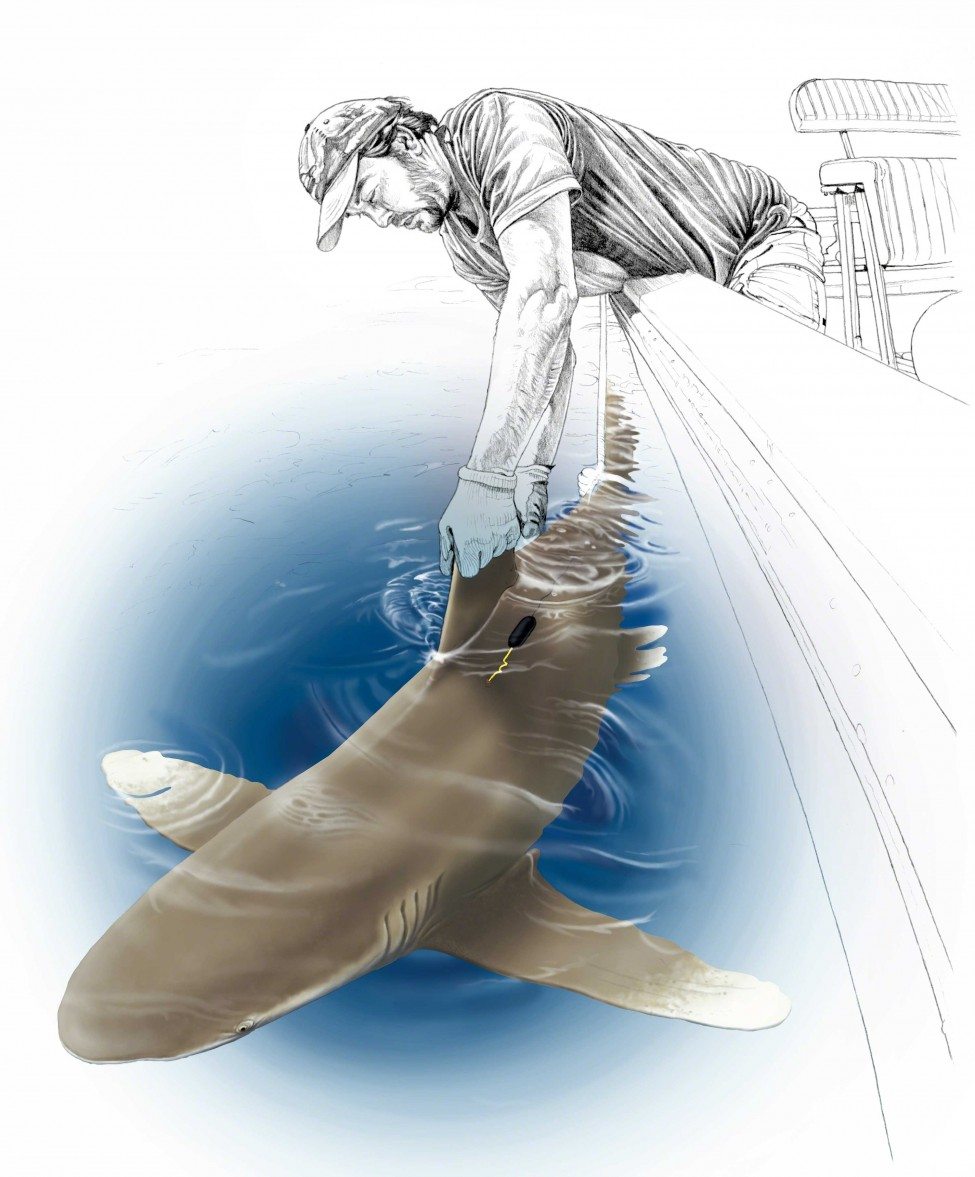Blue water, white tips
Demian Chapman, assistant professor at Stony Brook University’s School of Marine and Atmospheric Sciences, paints an emerging portrait of the oceanic whitetip shark Carcharhinus longimanus.
Photo © Todd Winner
The oceanic whitetip shark Carcharhinus longimanus is an enigmatic animal. One of only a handful of sharks that has evolved to live in pelagic waters off the continental shelf, it thrives in a hostile environment alongside some of the ocean’s fastest hunters, like tuna and billfish. It probably even preys on these swift giants, though we have no idea how the bulky and seemingly languid oceanic whitetip could manage this feat.
I have been fascinated by this species since I first saw it in Peter Gimbel’s 1969 film Blue Water, White Death: the Hunt for the Great White Shark. The film culminated in some of the first footage ever seen of white shark cage-diving, yet it was the images of Gimbel’s crew diving among scores of large oceanic whitetips off South Africa that seemed more impressive to me. So when my friends and colleagues Lucy Howey and Dr Lance Jordan from Microwave Telemetry asked me if I wanted to help them study this little-known species I was immediately hooked. Microwave Telemetry manufactures pop-off satellite archival tags (PSATs) that enable researchers to track marine animals remotely. Lucy and Lance felt that they could use this technology to shed new light on the lives of these blue-water apex predators.
There are two major obstacles that stand in the way of getting to know the oceanic whitetip. The first is obvious and common to all pelagic sharks and rays: the species lives far from land, at least for most of the time. The cost and logistical difficulties involved in observing it are orders of magnitude greater than those involved in observing, say, a shark associated with coral reefs. In most parts of the world the only people who regularly interact with oceanic whitetips are open-ocean commercial fishermen such as long-liners and purse-seiners. Scientists rarely have the opportunity to study them.
The second barrier to researching the oceanic whitetip, at least in contemporary times, is that it has become quite rare – a situation that would probably have been unthinkable in Jacques Cousteau’s era. In those days, anyone who regularly boated, fished or swam in warm, deep blue water had a story or two to tell about whitetips. In the space of a few decades, however, industrial pelagic fishing fleets have had a massive impact on the species.
Whitetips readily took bait intended for the more valuable tuna and billfish and were well known – and hated – for attacking hooked fish. Hemingway immortalised this habit in The Old Man and the Sea when the great catch of Santiago, the principal character, was ultimately annihilated by a pack of sharks. If the story were true, the sharks would almost certainly have been whitetips. So when a whitetip was hooked in the early days of pelagic fishing, it’s a safe bet that it was not released gently back into the water.
The problem for whitetips ratcheted up a notch when the Chinese economy boomed in the closing decades of the 20th century and, as a consequence, a market for shark fins developed. The popularity of shark-fin soup as a delicacy surged when the newly wealthy middle class in China began consuming all manner of luxury dishes in hitherto unheard-of quantities. Although the large, rounded fins of the whitetip (called ‘rolling ball’ by fin traders) are not especially coveted as fins go, they were good enough. More importantly, large quantities of them could be readily obtained by fleets on the high seas. And so the great liquidation of Carcharhinus longimanus began.
Marine scientist Dr Shelley Clarke estimated that the fins of between 400,000 and 1.5 million oceanic whitetips were traded globally in 2000 alone. Her team later showed that between 1996 and 2009 the catch rate for this species plummeted by about 90% in the South Pacific, providing compelling evidence that fishing pressure had surpassed sustainable limits. This certainly rang true for me. In 2010 I visited a shark fin exporter’s warehouse in Suva, Fiji, the global hub to which shark fins from all over the South Pacific are transported before onward shipment to Hong Kong. Dried shark fins were stacked in piles that I could have climbed – and more than a quarter of them were from oceanic whitetips.
We have less data on this species in other parts of the world, where in many cases the largest declines probably occurred earlier than in the South Pacific. But the result appears to be the same: there are many old-timers’ stories about encounters with oceanic whitetips, but very few or none from recent years. Lucy and Lance were keen to use their PSATs to learn how we can better protect oceanic whitetips and restore their populations.
When we began to think about studying oceanic whitetips in the Atlantic our initial question was, ‘Where?’ My wife, Debra Abercrombie, gave us the answer. Then working for the National Marine Fisheries Service Pelagic Observer Program, Debbie knew who to talk to in the fishing community. Their recommendations were unanimous: Cat Island in The Bahamas. Anglers spoke of recent encounters with whitetips close to the island in spring, when the sharks often trailed the boats and attacked hooked gamefish before they could be boated.
Friends and colleagues Sean Williams, Annabelle Brooks and Dr Edward (Edd) Brooks from the nearby Cape Eleuthera Institute rounded out the team to scout the site and see what we could do there. Low on funds but high on hope, the first expedition took place in spring 2011. Subsequently funded by the Save Our Seas Foundation, the Moore Bahamas Foundation and the Pew Charitable Trusts, we have been there every spring since to find out more about the region’s whitetips, where they go and what they do. What we experienced on our initial visit was nothing short of a lost world in which the whitetip still rules the blue.
Blue water, white tips
Oceanic whitetip sharks are formidable predators that have carved out a niche in the open ocean where prey is scarce. Once plentiful, they are now in serious trouble, but Demian has discovered an aggregation site that represents hope for one of the boldest fish in the ocean.

